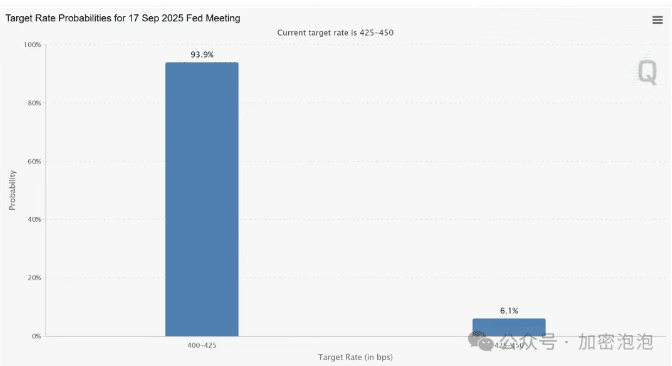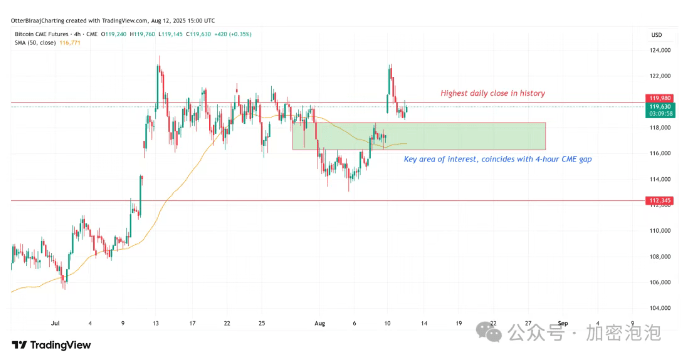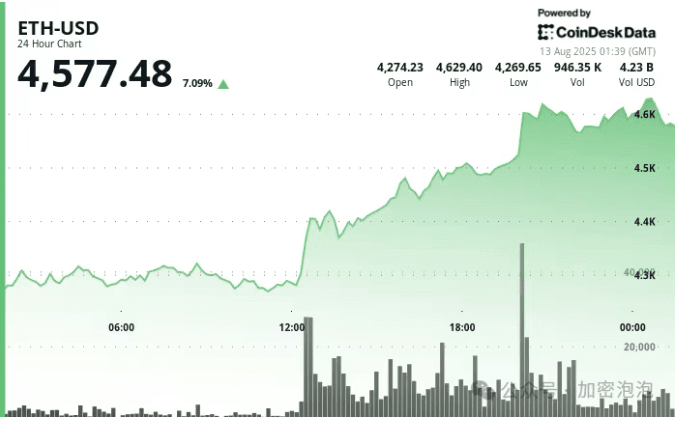On Wednesday (August 13), during the Asian session, Bitcoin attempted to stabilize above $119,000, while Ethereum broke through the $4600 mark, continuing its strong momentum.
After the release of the US July CPI, the market's bets on a 50 basis point rate cut have significantly heated up. Data shows:
CPI year-on-year: 2.7%, unchanged from June, below the expected 2.8%.
Core CPI year-on-year: 3.1%, in line with expectations.
CPI month-on-month: 0.2%, lower than the previous value of 0.3%.
Core CPI month-on-month: 0.3%, higher than the previous value of 0.2%.
Overall, this data leans towards mildly positive — cooling inflation provides a reason for a shift in monetary policy, supporting risk assets. A lower interest rate environment means the opportunity cost of holding BTC decreases, which may attract new funds.
CME FedWatch tool shows that after the CPI release, the market's probability of a rate cut in September surged to 93.9%, with investors clearly leaning towards expecting the Federal Reserve to relax policy in the second half of this year. However, the core CPI meeting expectations also means that price pressures have not been completely eliminated, and the Fed may wish to wait for more data confirmation before taking action.

Next, focus on PPI, which may serve as a further catalyst for BTC.
Market attention turns to the PPI (expected 2.3%) and core PPI (expected 2.5%) later this week. If these two data points come in below expectations, it will further confirm the trend of declining inflation, strengthen rate cut expectations, and enhance buying momentum for risk assets.
BTC: $120,000 is a watershed, breaking through or looking towards $130,000–$137,000.
Last weekend, BTC showed positive momentum, reaching a high of $122,190 on Monday, then falling back 3% to $118,500, failing to close above $120,000.
After the CPI data was released, BTC rebounded to $119,500, and whether it can continue to rise in the short term depends on whether it can effectively close above $119,982. If the daily close breaks above $120,000, it will be a historical first, potentially triggering a new round of increases, with target ranges looking towards $130,000–$137,000.

From a technical perspective, the bullish flag pattern at the daily level has broken upward, and the current pullback may be a retest to confirm support. Analyst TitanofCrypto believes that based on the breakout of the downtrend line on Sunday, BTC could optimistically reach $137,000.
Conversely, if it fails to hold above $120,000, it may short-term retreat to the support range of $117,650–$115,650, which overlaps with the CME gap formed over the weekend. Cointelegraph warns that even at high levels, the possibility of BTC deeply retracing to $95,000 cannot be ruled out.

ETH: The increase is stunning, approaching an all-time high.
Ethereum strongly broke through $4600 during the day, with a 24-hour increase of nearly 10%, as the market rapidly digests the possibility of a rate cut in September.

Polymarket betting data shows:
By the end of August, the probability of ETH breaking through $5000 is considered very high;
About 28% of participants are betting that it will stand above $5800 before the end of the month.
The rapid rise of ETH has also caused BTC's market share to drop from 65% to 59%, with funds accelerating their flow to other mainstream assets.
Glassnode data shows that ETH is now approaching the 'active realized price' 1 standard deviation range near $4700 — this price level has often been accompanied by significant selling pressure in past cycles.
Potential concern: Liquidity is flowing out to Tron.
CryptoQuant reports that ETH is increasingly becoming a liquidity supplier for the Tron (TRON) USDT ecosystem:
On August 9, a record $7.7 million ETH was transferred to Tron through cross-chain and exchanged for USDT;
On June 25, there was also a $19 million outflow of ERC20 tokens (mainly USDC) in a similar manner.
The funds flowing back to Ethereum are almost negligible, which means that the trading volume of stablecoins on Tron is increasing, but the liquidity of ETH native DeFi is being weakened.
In the long term, this may lead to:
Spot demand is declining;
Fee income and staking rewards are decreasing;
ETH is increasingly resembling a 'supply layer' for wholesale liquidity for other chains, rather than capturing trading volume itself.
In the short term, this may not disrupt the upward trend, but if funds continue to flow out, whether high valuations can be maintained will be a question mark.
The mildly positive CPI data has led BTC and ETH both to enter a strong range. If BTC breaks above $120,000, it will open up upward space above $130,000; ETH is just a step away from its historical high. However, the structural changes in liquidity flow also remind investors to remain cautious amid excitement.

